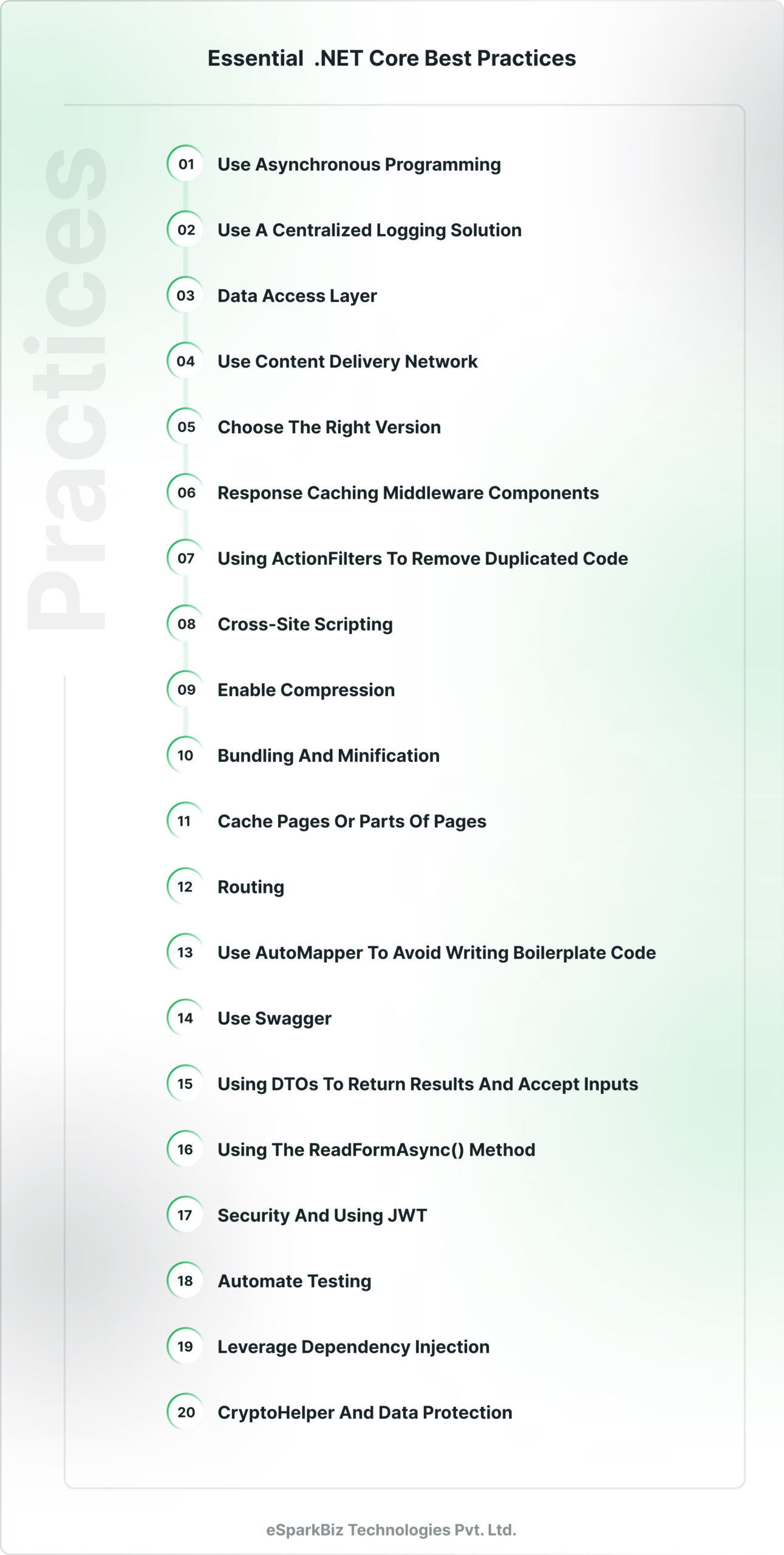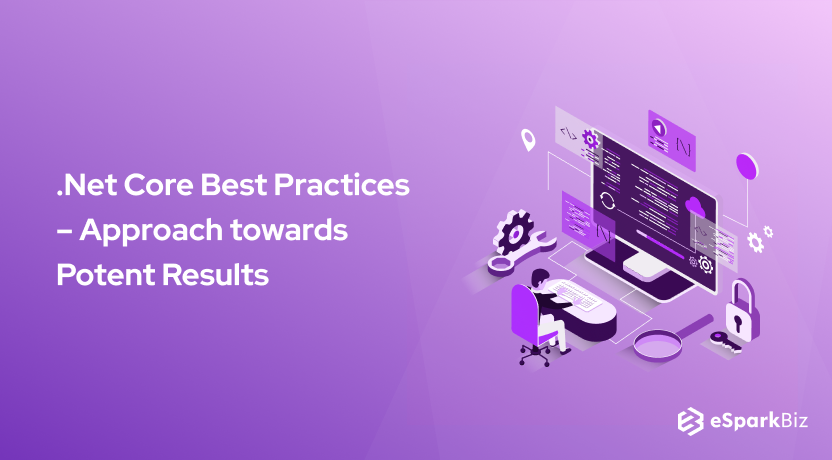Microsoft developed and maintains .NET Core, an open-source, free, quick, lightweight, and cross-platform web development framework. Operating systems for Windows, Linux, and MAC are supported by .NET. Although it isn’t an updated version of .NET, it gives developers easy access to govern typical program flow. It has a completely new design and only supports the .NET Web API and .NET MVC development models. The .NET Core is built with speed as a priority, making it more performance-oriented.
Load time is one of the crucial factors that affect a site’s success when it concerns functionality of a website or application. When compared to a one-second loading speed, a mobile page’s bounce rate rises by 123% with a 10-second load time.
And for this reason, companies prefer to have a perfect and reliable web application. .NET Core is one of the best technologies for the same. The.NET Framework and .NET Core were combined into one category in a poll published by Stack Overflow in 2022. It was the most popular framework this year, rising from 34.2 percent to 34.55 percent in popularity.
Let’s examine the .NET core best practices to learn more about this technology and the ways it enhances the performance of the application.
Essential Dot NET Core Best Practices

Use Asynchronous Programming
Asynchronous programming is a crucial .NET Core recommended practice for creating scalable, responsive, and effective apps. It entails running multiple actions simultaneously without halting the thread of execution or forcing the application to pause while waiting for a job to finish.
Developers can take advantage of the async/await keyword support in .NET Core to leverage asynchronous programming, which makes it easier to write asynchronous code. These keywords enable developers to run time-consuming tasks in the background and receive alerts when they are finished, all without obstructing the execution of other threads.
Use a centralized logging solution
One of the recommended .NET Core best practices is to use a centralized logging solution. A centralized logging solution collects all of the application’s component logs in one place. Developers can more easily comb through logs to detect faults because they just need to look at one area rather than collecting logs from many sources. Developers can also use it to look for trends and recurring patterns in the logs.
.Elasticsearch, Splunk, and Application Insights are just a few of the centralized logging platforms that can be integrated with .NET Core, thanks to the built-in support for a range of logging sources. For easier analysis in situations where numerous nodes are cooperating, developers can set their software to save log data to a shared location.
Data Access Layer
The Data Access Layer (DAL), a key part of a program in .NET Core, controls communication between the application and databases. The DAL is an asp net core architecture best practice that decouples the application logic from the database. It allows the application code to access the database generally.
The DAL offers an interface for data querying and updating while creating a barrier between the business logic and data storage layer. Lowering reliance on certain technology promotes maintainability and allows for flexibility in database implementation.
Use Content Delivery Network (CDN)
With caching and distributing static assets from nearby servers, a Content Delivery Network (CDN) is a crucial best practice for .NET Core since it enhances online application speed. By optimizing page load times, this lowers server load, boosts availability, and improves user experience.
Choose the Right Version
It is extremely crucial that you choose the right .NET Core version for your project. New features or upgrades introduced by newly released versions may have an effect on your program. By selecting the appropriate version, you may use the most recent features without compromising functionality while also ensuring that your application is still compatible with the version.
By using an older version, you run the risk of missing security updates or losing Microsoft’s support, which could result in security problems. The efficiency and productivity of your application may also be enhanced by adopting a newer version of .NET Core, which may also provide new features and advancements.
Also Read : What’s New in .NET 7 ?
Response Caching Middleware Components
Another best practice in .NET Core development is the use of response caching middleware components. They reduce server load and enhance application speed by caching frequently used HTTP answers. As a result, clients receive faster responses and there are less needless queries made to the server, improving the user experience.
Using ActionFilters to Remove Duplicated Code
In .NET Core, ActionFilters are a potent method for adding universal concerns like logging, caching, and authorization to controller operations. Using ActionFilters, which are net core logging best practices, one can get rid of duplicate code.
It will be easier to maintain and less likely to introduce issues if filters are applied to many actions rather than duplicating code. Since functionality is centralized in ActionFilters, developers may simply change behaviour without having to make changes to numerous places in the codebase.
Cross-Site Scripting
A form of security flaw in web applications called cross-site scripting (XSS) enables attackers to insert malicious code into web pages that other users are seeing. Important Dot NET Core recommended practices for preventing XSS attacks include input validation, output encoding, and the installation of content security policies.
User input is validated to make sure it adheres to the desired format and values. User input can be shown as plain text rather than executable code thanks to output encoding. The source origins of JavaScript and other resources on web sites are restricted by content security policy.
Enable Compression
By dramatically lowering the amount of data that needs to be sent between the client and server, compression can improve performance and lower bandwidth costs in your .NET Core application. This is crucial for faraway clients or mobile devices with constrained bandwidth.
GZip and Deflate are the two most popular compression algorithms utilized in .NET Core.
It is advised to turn compression on at the web server level. By doing this, you can assure that all responses are automatically compressed without having to update your code.
Bundling and Minification
The two main .NET Core development best practices that enhance website performance are bundling and minification. Several CSS and JavaScript files are bundled together into a smaller number of files to speed up loading.
After then, minification shrinks the size of these files by eliminating blank lines, comments, and other extraneous components, further increasing speed. A quicker, more responsive website that improves user experience and lowers server load is the ultimate result.
Cache Pages or Cache Parts of Pages
In Dot NET Core, caching pages or portions of pages is a crucial best practice that enhances application speed. Caching minimizes the number of queries made to the server and speeds up page rendering by loading frequently requested content into memory.
Applications can give consumers faster response times, save server strain, and enhance user experience by caching pages or portions of pages. Cache Pages or Cache Parts of Pages is indeed one of the asp net core best practices.
It’s crucial to remember that caching techniques and strategies should be carefully chosen to prevent having a negative influence on application performance or introducing security flaws.
Routing
One of the crucial best practices that supports the development of web applications in .NET Core is routing. Routing is the process of connecting HTTP requests made by web browsers with the actions (controller method) that should be taken in response. It has proved to be asp net core best practices.
By dividing application logic into reusable, modular components, it is possible for developers to make it simple to add or delete functionality without affecting other areas of the application.
By minimising pointless server queries and maintaining the security of URLs, proper routing also contributes to increased application performance and security. In conclusion, routing is essential for creating .NET Core applications that are effective, adaptable, and safe.
Use AutoMapper to Avoid Writing Boilerplate Code
AutoMapper is a well-liked tool for mapping data across objects. You can avoid writing repetitive and error-prone mapping code by using AutoMapper which is one of the asp net core architecture best practices.
This shortens the overall development time and enables developers to design more concise, reuseable code. Using AutoMapper can be a crucial best practice for .NET Core applications because it speeds up the development process and maintains clear, well-structured code. Developers can devote more time to high-level tasks that are essential to the project’s success by automating object mapping.
Use Swagger
Since Swagger helps to enhance API documentation, testing, and debugging procedures, using it in .NET Core is a crucial best practice. Developers may rapidly and effectively design, document, and test APIs with this strong tool.
The creation of an intuitive user interface by Swagger makes it easier to integrate API endpoints across various platforms. Swagger implementation can enhance the overall quality and usability of your .NET Core applications while saving time and resources.
Using DTOs to Return Results and Accept Inputs
A crucial best practice for .NET Core programming is to return results and accept inputs using Data Transfer Objects (DTOs). It contributes to code simplification, performance enhancement, and network data transfer reduction. In a distributed system, DTOs are used to transport data between levels and encapsulate domain entities.
Developers can prevent the disclosure of critical information to unreliable clients by utilizing DTOs. This creates a clear separation of responsibilities between the frontend and backend components of their program. Overall, this method enhances security, scalability, and maintainability.
Using the ReadFormAsync() Method
An essential .NET Core recommended practice for handling form submissions is the ReadFormAsync() function. It offers faster performance and more efficient resource use by enabling developers to read and process HTTP form data asynchronously.
To avoid security flaws and unexpected results, it’s crucial to ensure that any validation or error handling is provided. Developers may make their apps more effective, secure, and trustworthy by adhering to this best practice.
Security and Using JWT
A crucial component of developing any program is security. The usage of JWT (JSON Web Tokens) for secure authentication and authorization in .NET Core is one of the Dotnet core best practices. JWT offers a standardized process for securely exchanging claims between parties.
Developers may assure that critical data is safe from outside threats by using JWT in conjunction with robust encryption methods. This ensure that all user information is safe and secure where only authorized users can use the resources.
Automate Testing
Automated Testing is one of the key .net core best practices in dot NET Core development. During the development phase, it entails employing specialized testing tools to automatically run tests on software components. This increases efficiency and accuracy by spotting problems earlier, saving money, and guaranteeing the integrity of the software.
By using a variety of frameworks including MSTest, NUnit and xUnit, you can easily accomplish Automated testing in NET Core. Developers may create applications that are more reliable and resilient by putting automated testing practices.
Leverage Dependency Injection
One of the crucial Dot Net core best practices supporting testability, maintainability and loose coupling is the use of dependency injection. Developers have more control over lifespan and behavior of programs by specifying dependencies to components instead of directly generating them.
This lessens the degree of tight coupling between parts and makes it easier to control the software complexity with time. Effective dependency injection can ultimately enhance the overall quality of the code and development effectiveness.
CryptoHelper And Data Protection
CryptoHelper and Data Protection is an essential .NET Core practice for protecting sensitive data. These procedures use cryptographic methods and functions to protect data against theft and unauthorized access.
The Data Protection class offers secure storage and retrieval of sensitive data using machine-specific keys. CryptoHelper class offers a variety of ways for encrypting and decrypting data. Implementing these best practices in .NET Core apps can decrease the risk of data breaches and cyberattacks.
Conclusion
To sum up, following the above mentioned .NET Core best practices is crucial for creating excellent and durable .NET Core applications. Coding, testing, and deployment practices that are consistent lead to improved user experience, higher security, and optimized speed.
Using tools like Azure DevOps, Visual Studio Code, and Swagger makes it easier to streamline development chores. It also helps in keeping track of application’s health.
Agile methodology adaptation makes it easier for team members to collaborate, offer quicker feedback cycles and react swiftly to changes.
Also, creating cutting-edge .NET Core applications requires constant skill development and staying up with the current trends.
How can eSparkBiz assist you in .Net Development?
For individuals looking for Eminent .Net Development Company, eSparkBiz can prove to be the best solution. They can offer direction on creating software applications leveraging the .Net framework. eSparkBiz provides various services such as support, testing and creation of tailored applications.


-
What is the importance of Dependency Injection in .NET Core?
A built-in capability of .NET Core called Dependency Injection encourages loose connectivity between components in an application. The application becomes more testable, maintainable, and modular as a result.
-
How can I improve performance in my .NET Core application?
The uses of asynchronous programming, LINQ query optimization, memory allocation minimization, and caching techniques are just a few of the asp net core best practices that can help .NET Core apps run faster.
-
Why is it recommended to use a logging framework in .NET Core?
Developers may keep track of mistakes, fix problems, and monitor application performance by utilizing a logging framework in .NET Core. Additionally, it offers a centralized location for log retrieval and storage, which facilitates management and analysis.



